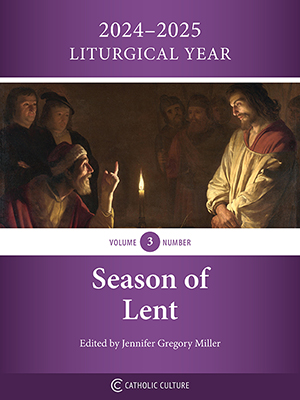This week: Pachamama and other scandals
By Phil Lawler ( bio - articles - email ) | Oct 25, 2019
Yet again the Amazon Synod—controversial though it is—has been bumped off the top place in our list of the week’s headline stories by a stunning and scandalous development at the Vatican. In fact, two stunning and scandalous developments. Or even more than that, depending on how you count the separate stories.
Free eBook:

|
| Free eBook: Liturgical Year 2024-2025, Vol. 3 |
Very early Tuesday morning, two men entered the church of Santa Maria in Traspontina, just down the street from St. Peter’s Square, and removed the Pachamama statutes that have been a focus of attention since before the start of the Synod. They proceeded to toss the statues in the river, then posted a videotape of their actions on the internet—prompting hearty applause from many Catholics who had seen the statues as pagan idols.
This nasty controversy might have been avoided, if Vatican officials had offered some reasonable explanation for the display of these statues. But they didn’t, and probably couldn’t. After early suggestions that the statues were primitive images of the Virgin Mary, Synod officials admitted that they were not. But what were they? Symbols of motherhood? The Pachamama is revered in some South American cultures a fertility goddess. So was this a pagan idol, being set before the altar of a Catholic church? That conclusion was hard to avoid, especially when photos circulated across cyberspace, showing people bowing down before these images during a ceremony that was held in the Vatican gardens—with Pope Francis in attendance.
By the end of the week Vatican officials were stretching for an explanation of the affair. Paolo Ruffini, the prefect of the dicastery for Communications, made the astonishing claim that “there was no ritual, no prostration took place”—despite the clear photographic evidence. Pope Francis simply declared that the statues were displayed “without blasphemous intentions.” Yet in the same statement, the Pontiff clarified that the statutes were representations of the Pachamama—which, again, is a fertility goddess.
Pope Francis went on to say that “as bishop of the diocese I ask pardon of the persons who were offended”—not by the display of the Pachamama images, but by their destruction.
And wait. The Pope also revealed that the statues had not been destroyed. They had been recovered from the Tiber, he said, and might be on display in St. Peter’s basilica during the closing Mass of the Amazon Synod. If they are—and we’ll know within a matter of hours—the gesture would be a direct and intentional affront to the thousands of believers who have been horrified by the prominence given to those idols. More to the point, wouldn’t it be an affront to the “jealous God” who warned his people not to place false gods before Him?
Almost lost in the welter of stories about the statues, the Amazon Synod received a final document on Friday; it will be submitted to the full assembly for approval on Saturday. The drafting of this final document—by a committee dominated by the Pope’s hand-picked favorites—has been shrouded in secrecy. But reliable sources indicated that it would probably include a recommendation for the ordination of mature married men, and for some form of official ministry, similar to the diaconate, for women. These recommendations could face opposition, and a two-thirds vote is required for official approval by the Synod. But bear in mind that—despite all the talk about “synodal” government—the Synod is merely an advisory body, and the final results of the assembly will be determined by the Pope, when he writes his apostolic exhortation based on the Synod’s deliberations.
Meanwhile a new set of financial scandals scuttled any lingering hopes that the Vatican has made progress toward transparency and accountability in that realm. On Monday one Italian investigative journalist, Emiliano Fittipaldi, broke the story that the Secretariat of State had invested over $700 million in “reckless speculative operations,” using funds from the worldwide Peter’s Pence collection. Fittipaldi quoted a leaked document from Vatican prosecutors, saying that the unauthorized transactions showed “serious indications of embezzlement, fraud, abuse of office, money laundering, and self-money laundering.”
Then another investigative journalist, Gianluigi Nuzzi, revealed that the administration of the Patrimony of the Apostolic See (APSA) issued a €50 million loan to a troubled Italian hospital, despite regulations that bar APSA from making such transactions—and then pressured the Papal Foundation to make its own improper gift of $25 million to help cover the loss on APSA’s books.
(By the way, if the names of those investigative journalists sound familiar to you, there is a reason. Fittipaldi and Nuzzi were defendants in the “Vatileaks II” trial. They now say that they have over 3,000 newly leaked confidential documents, so we can expect many more uncomfortable revelations in coming weeks.)
Nuzzi wrote that Vatican’s budget problems have become critical, because of steep declines in the Peter’s Pence collection ( from €101 million to about €60 million in the past dozen years). Bishop Nunzio Galantino, the president of APSA, insisted: “There is no risk of collapse or default here.” But that sort of public statement is never reassuring. Once even the possibility of default is mentioned aloud, potential donors cannot easily ignore it. In light of this season of scandals, contributors to the Peter’s Pence collection might wonder whether their dollars will go to papal charities or to speculative investments in Angolan oil exploration.
Or, for that matter, toward the display of Pachamama statues.
All comments are moderated. To lighten our editing burden, only current donors are allowed to Sound Off. If you are a current donor, log in to see the comment form; otherwise please support our work, and Sound Off!
-
Posted by: AgnesDay -
Nov. 17, 2019 7:10 PM ET USA
The Vatican no longer receives any direct material support from me, as of the first of this year. I was always happy to participate in Peter's Pence and other good works, but contributions are fungible, and prudence is a virtue in very short supply. Even if the Holy Father ( a title that chokes me to use)knew nothing of this scandal, he should have; and he has no excuses.
-
Posted by: Bveritas2322 -
Oct. 28, 2019 11:36 AM ET USA
I guess in a "new Catholic Church" with a clergy that rapes children and with Cardinals and theologians who praise abortion rights, the depraved indifference to the burying of children alive by these idolized native cultures does not even merit notice as a scandal.
-
Posted by: Retired01 -
Oct. 27, 2019 3:11 PM ET USA
The drip, drip, drip is becoming a torrent while our wishy washy bisops look the other way and ignore the whole debacle.
-
Posted by: FredC -
Oct. 26, 2019 1:11 PM ET USA
Let's hope and pray that appearances are deceiving.
-
Posted by: MWCooney -
Oct. 26, 2019 10:25 AM ET USA
Lord, please give me the grace to avoid despair, for I am weak, and I cannot do it on my own. Let me truly trust you when I say, "Thy will be done."
-
Posted by: feedback -
Oct. 26, 2019 10:03 AM ET USA
Why didn't Francis ask the Church for pardon after media report that he had said he doesn't believe in the divinity of Christ? It offended Catholics worldwide.
-
Posted by: koinonia -
Oct. 26, 2019 9:50 AM ET USA
Ironically, tomorrow marks the 33rd anniversary of the placement of a statue of Buddha on the main altar at St. Peter's in Assisi. Approving altar girls long ago, extraordinary ministers etc. and so many "reforms" prior to Pope Francis serve to embolden his self-proclaimed effort to push further. He sees himself as one continuing to push boundaries, one expanding previous reforms, one furthering realizing the conciliar dream. We must have the courage to ask honestly: "How did we get here?"







